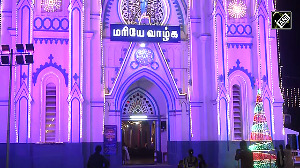More than any major political party or radical Left Front, it is documentary filmmakers who have emerged as the biggest adversaries of Gujarat Chief Minister Narendra Modi. An impressive body of anti-Modi films accumulating since 2002, are now a ubiquitous part of the 'documentary festival' circuit, delivering compact body blows to the reputation of Hindutva's puffed up poster boy.
Last week, at the brilliantly organised 'Film Southasia '09', Kathmandu, I had a ringside seat to the intense response of Nepali audiences to three films that refer to the goings on in Gujarat. While Lalit Vachani's The Salt Stories (2008), which shared the second prize, pointed out with deft subtlety the contrast between Gandhiji's Dandi march to unify the country and the communally divided villages today along the same route, Shubhradeep Chakravorty's Encountered on Saffron Agenda? (2007) is a frontal attack on the lies of the Gujarat administration to cover-up five major 'encounter' incidents. Amar Kanwar's The Lightning Testimonies (2007) too casts a glance at the 'sexual politics' at the core of communal conflict in Gujarat and other parts of the sub-continent.
Encountered on Saffron Agenda? comprehensively, if laboriously, covers the 'encounter' deaths in Gujarat of Ishrat Jahan and Javed Sheikh (June 2004), Sohrabuddin Sheikh (November 2005), Sameer Khan Pathan (October 2002) and Sadiq Jamal (January 2003). In each case, the state police claimed that those killed were out to assassinate Chief Minister
Modi. The film-maker interviews the victims' families, independent investigators, lawyers and eyewitnesses to conclude that these fake encounters not only violated the victims' fundamental right to life and liberty but were used to "demonise minorities and strengthen the politics of hatred" in Gujarat. In the current context of the strictures passed against the Gujarat police by Justice Tamang and the order to re-investigate the case of Ishrat Jahan, the film needs to be widely screened.
One of the most worrying aspects of post-pogrom Gujarat has been the public circulation of video footage of the brutalities that mobs inflicted upon Muslim victims. The story slowly emerged of how amateur and professional videographers in villages and small towns, typically eking out a living filming weddings and other family functions, were either voluntarily or forcibly recruited to turn their cameras on the assault, rape and murders that were being carried out in the streets. It was even suggested then that many of the brutalities were specially performed for camera. Subsequently, these 'video films' quietly slipped on to the shelves of video lending libraries and are said to be 'popular' weekend viewing even today.
Interestingly, however, the communal hatred 'popularised' through the camera is now being critiqued too, equally forcefully, through the camera. One of the earliest salvos was by 28-year old Gopal Menon, whose 28 minute-long film Hey Ram: Genocide in the land of Gandhi (2002), in fact, took recourse to some of this floating footage of the carnage. The filmmaker was categorical that, "It was not a communal riot but planned genocide." He interviewed almost a hundred victims, 15 of whom have been featured in the film and include people who witnessed their family members being killed. The film has had a few thousand screenings by now.
Also in 2002, two other documentaries, both by Delhi-based Gauhar Raza, were to shed light on the systematic manufacture of the escalating communal tension in Gujarat. In Dark Times and Junoon ke Badhte Kadam, both warned us of the surplus hatred which the state was cashing upon.
In 2003, Shubhradeep Chakravorty made his first film Godhra Tak: The Terror Trail, which cast deep doubts on the theory of the 2002 pogroms being a 'spontaneous' reaction to the death of kar sevaks in the train fire at Godhra.
The largest body in this genre of documentaries belongs to Rakesh Sharma whose pugnacious Final Solution (2004) set the cat among the pigeons and earned it a ban in Gujarat and official festivals, even as it went on to win awards globally. The film dwells on the vicious attacks on Gulbarg Society and in Naroda Patiya and the violence against Muslim women
in Eral as well as in the Panchmahals, even as the CM goes on a gaurav yatra across the state. His subsequent films Aftershock: A Rough Guide to Democracy (2006), Khedu Mora Re and Chet'ta Rejo (both 2007) stick to the theme of a steady dismantling of democratic polity in Gujarat under the cloak of its much touted investor-friendliness and new prosperity.
Other documentaries like NID graduate Akhila Krishnan's Words in Stone (2005), TV journalist Shikha Trivedy's Gujarat's New Muslims (2007) and Pankaj Shankar's In the Name of Faith (2007) complete the picture. Of course, Rahul Dholakia's 2007 feature film Parzania eventually achieved the impact many of these documentaries could not.
It's time for a festival called 'Modi-In-Camera'. Any takers?






